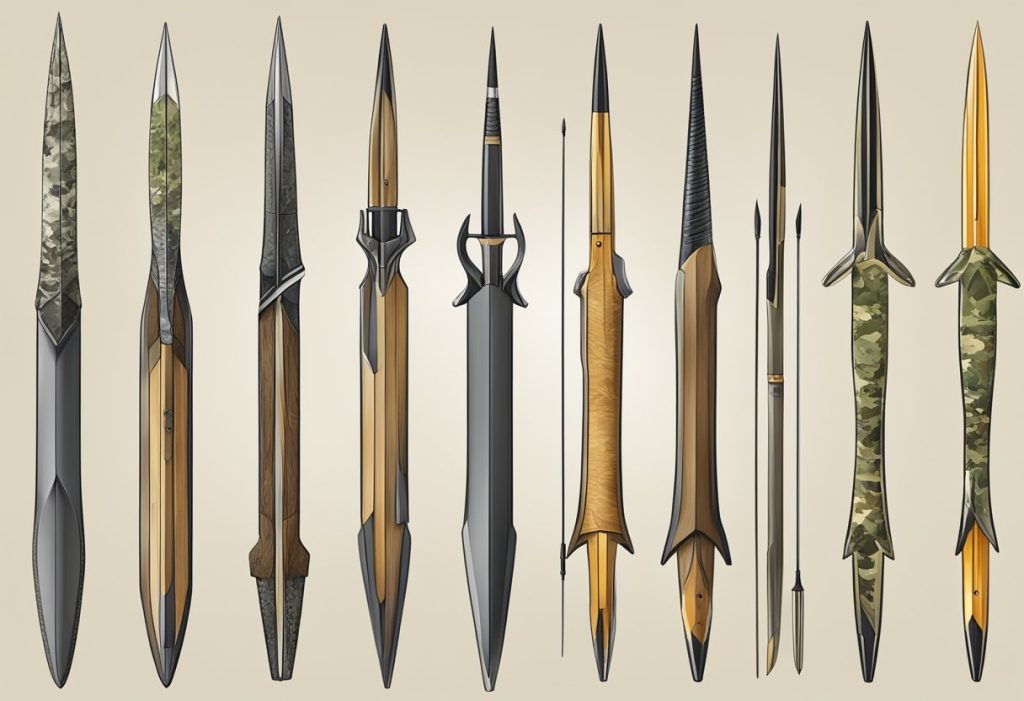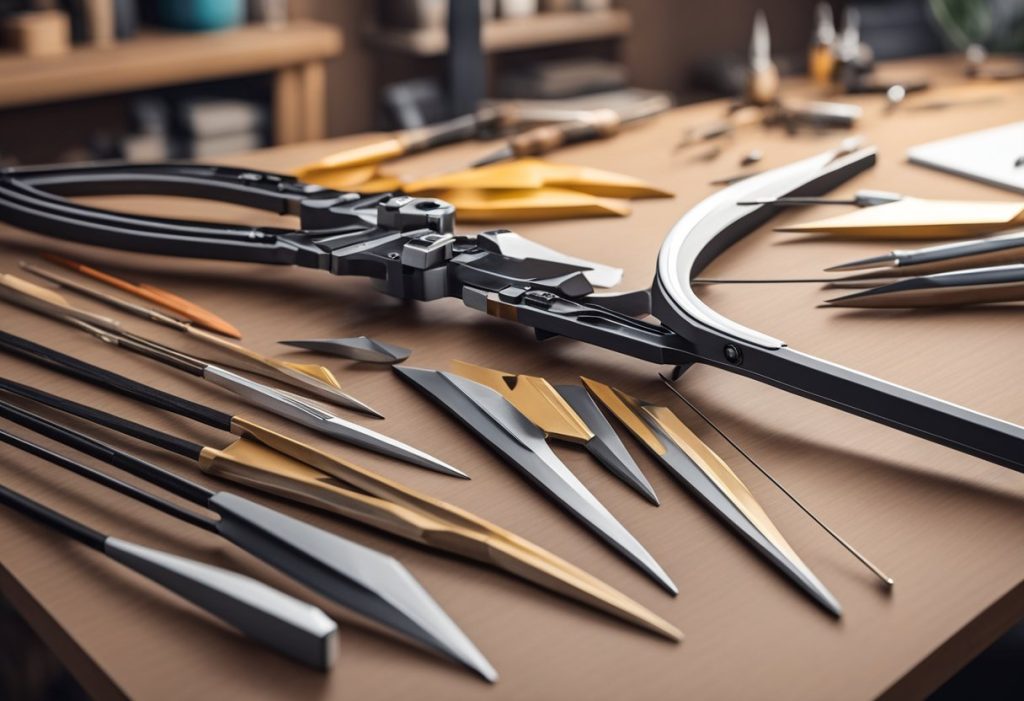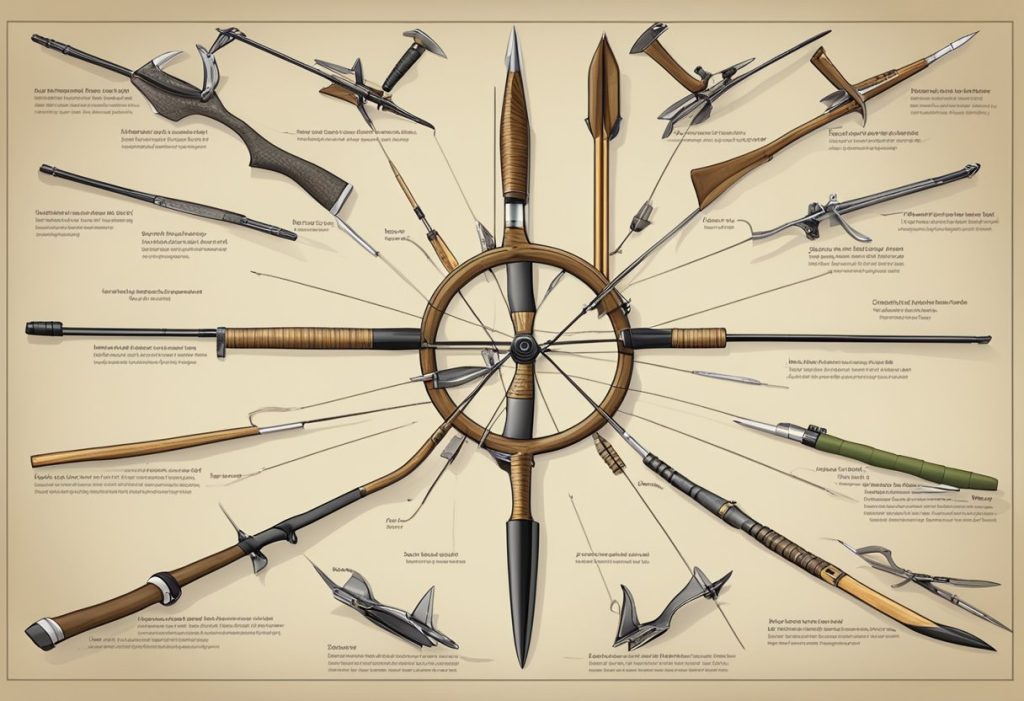
Broadheads play a crucial role in recurve bow hunting and archery, determining the good success of a shot and the overall hunting experience. As technology and innovation continue to evolve, choosing the right broadhead for your recurve bow becomes both easier and more complicated. In this article, we will explore different types of broadheads, factors to consider when selecting a broadhead, and some recommended brands and models suitable for recurve bow hunters.
Selecting the perfect broadhead involves understanding the various types available, such as fixed blade, mechanical heads, or hybrid designs, and their impact on penetration, accuracy, and damage. The construction and material of a broadhead also play a significant role in the product’s performance and durability. Additionally, setting up and tuning your broadheads for optimal performance is crucial in maximizing the potential of your recurve bow.
Considering the vast range of options available, understanding the specific needs and requirements of your hunting style, environment, and draw weight will help you make an informed decision. Our recommendations and answers to frequently asked questions will further assist you in making the best choice for your recurve bow hunting and archery experience.
Key Takeaways
- Understand the different types of broadheads and their impact on hunting performance
- Consider the material, construction and proper tuning of a broadhead for optimal results
- Evaluate personal needs, environment, and draw weight when selecting a suitable broadhead model
Types of Broadheads for Recurve Bow Hunting
Fixed Blade Broadheads
Fixed blade broadheads are a personal choice for recurve bow hunters due to their simple and sturdy design. They typically consist of a single, solid piece of metal with two or more sharp bleeder blades attached to a central shaft. Some of the best fixed blade broadheads for recurve bows include the Carbon Express Nativ Broadhead, Grizzly Single Bevel, and Magnus Stingers. These broadheads are known for their strength, penetration, and reliability in the field.
Fixed blade broadhead also come in several configurations, including:
- Single bevel: These broadheads have only one blade that is sharpened on one side, resulting in a single cutting edge.
- Three- and four-blade: These multi-bladed broadheads typically offer greater cutting surface area, increasing the chances of a clean and quick kill.
Mechanical Broadheads
Mechanical broadheads have gained popularity among modern bow hunters for their increased accuracy, especially at longer distances. These broadheads have a number of blades that remain closed during flight and then expand upon impact with the target, resulting in a larger wound channel. Some of the best mechanical broadheads for recurve bows include the Ramcat Hydroshock and Rage Bowhunting Extreme.
However, some concerns with mechanical broadheads for recurve bow users include the possibility of reduced penetration due to the energy required for blade deployment. Still, with proper bow setup and arrow selection, its the only way success can be achieved with these broadheads.
Hybrid Broadheads
Hybrid broadheads combine the design features of both fixed blade heads and mechanical broadheads, aiming to provide the best of both worlds. Some popular hybrid broadheads include the Evolution Outdoors Hyde and the Sevr. They typically have a fixed blade for good penetration, as well as mechanical blades that expand upon impact, providing a larger cutting surface. By blending the strengths of both fixed head and mechanical broadheads, hybrid options aim to offer increased accuracy and devastating wounds.
Selecting the best broadhead for your recurve bow hunting and archery needs will ultimately depend on personal preference, intended game, and other environmental factors. Familiarizing yourself with the different types of broadheads and their respective strengths will help you make an informed decision and maximize your bowhunting experience.
Key Factors in Broadhead Selection
When it comes to selecting the perfect broadhead for recurve bow hunting and archery, there are several factors to consider. In this section, we will discuss three main factors that determine the success of a broadhead: weight and grain, arrow flight and accuracy, and penetration and cutting diameter.
Broadhead Weight and Grain
The total weight of a broadhead, typically measured in grains, is crucial to the performance of your arrow. Common weights include 100 and 125 grain. It directly affects the arrow’s momentum, spine, and required push force to maintain accuracy.
Here’s a brief overview of grain weights:
- 100 grain: Offers a faster arrow speed, maintaining a flatter trajectory.
- 125 grain: Provides more momentum, capable of deep penetration.
Choose a bow weight that complements the spine of your particular arrow and matches the tune of your long bow.
Arrow Flight and Accuracy
An essential aspect of broadhead selection is ensuring optimal arrow flight and accuracy. The broadhead should be designed to promote stable and true arrow flight, ultimately influencing the archer’s precision.
Factors that contribute to arrow flight include:
- Sharpness: Razor-sharp edges increase the broadhead’s accuracy.
- Edge retention: High-quality materials that maintain sharpness over time add to the accuracy.
- Design: The shape and aerodynamic properties of the broadhead influence the arrow’s stability during flight.
It’s important to fine-tune the combination of total arrow weight, spine, and broadhead design to achieve the best possible flight and accuracy.
Penetration and Cutting Diameter
An effective broadhead must be able to penetrate the target and create a sizable wound channel to ensure a quick and humane harvest.
The following factors determine best penetration and cutting diameter:
- Cutting diameter: Larger cutting diameters increase the size of the wound channel and affect the arrow’s penetration. For example, chisel point broadheads are known for their ability to handle tough bones and ligaments without deflecting or being damaged.
- Sharpness: As mentioned earlier, sharpness contributes to penetration as it allows the broadhead to smoothly enter the target.
- Momentum: Heavier broadheads, such as the Sharpshooter 200, maintain momentum and drive deep into the target, increasing penetration.
When selecting a broadhead, consider how these factors interact and prioritize the ones that best suit your hunting style and intended quarry.
Material and Construction of Quality Broadheads

Carbon Steel versus Stainless Steel
When it comes to broadhead construction, the choice of material plays a crucial role in determining the overall performance and effectiveness. Two of the most common materials used for broadhead construction are carbon steel and stainless steel. Carbon steel is known for its strength and durability, making it an excellent material for broadhead production.
However, it is susceptible to rust and corrosion. On the other hand, stainless steel is renowned for its resistance to rust and corrosion, while still offering good durability and edge retention.
Durability and Edge Retention
A quality broadhead should be durable enough to withstand the rigors of bow hunting and maintain its edge through multiple uses. The durability of a broadhead can be influenced by factors such as the thickness and hardness of the blade, the quality of materials used, and the manufacturing process employed.
For example, single bevel broadheads are known for their durability, as they generally have fewer moving parts and thicker replaceable blades than their multiblade counterparts.
Edge retention is another critical factor to consider, as it determines the broadhead’s ability to retain its sharpness after numerous uses. Good edge retention depends on the hardness and quality of the material used, as well as the sharpening angle of the blade. Both carbon steel and stainless steel broadheads offer good edge retention, albeit with differences in their corrosion resistance, as mentioned earlier.
To ensure lasting, reliable performance from your broadheads, it is important to invest in those made from quality materials and by reputable manufacturers. Some broadhead manufacturers even offer a lifetime warranty or lifetime replacement guarantee to demonstrate their confidence in their product’s durability. These guarantees can provide peace of mind and reassurance about the longevity of your broadhead investment.
While both carbon steel and stainless steel broadheads provide strength, durability, and edge retention, considering factors such as corrosion resistance and personal preferences can help determine the best option for your recurve bow hunting and archery needs.
Setting Up Broadheads for Optimal Performance
Proper setup and tuning of broadheads and recurve bows are essential for success in both hunting and archery. This section will discuss how to align and sharpen broadheads, as well as how to tune the recurve bow for optimal broadhead performance.
Aligning and Sharpening Broadheads
- Alignment: Before sharpening, it’s crucial to ensure that the broadheads are properly aligned with the arrow shaft. This can be done by using a “spin test” which involves spinning the arrow on a flat surface and observing any wobbling. A well-aligned broadhead will spin smoothly without any noticeable wobbling, indicating minimal resistance during flight. Make adjustments as needed to eliminate any wobble.
- Sharpening: The importance of sharp broadheads cannot be overstated, as a dull broadhead can lead to poor penetration and a wounded or lost animal. Use a broadhead sharpener or sharpening stone to achieve a razor-sharp edge. Sharpen each blade by rubbing it in a consistent direction across the stone, maintaining the original angle to ensure even sharpening. Remember to exercise caution while sharpening to avoid accidental injuries.
Tuning the Recurve Bow for Broadheads
- Arrow Selection: Begin by choosing arrows with the appropriate spine and weight for your recurve bow and the broadheads you intend to use. This will help to ensure optimal flight performance and consistency.
- Bareshaft Tuning: Start by shooting a bareshaft arrow (an arrow without any fletchings). Observe the flight of the arrow in relation to your target. Ideally, the bareshaft should fly straight and true without any noticeable fishtailing or porpoising.
- Broadhead Tuning: Now mount the broadhead on the arrow and begin shooting. Compare the arrow’s impact point with that of a field point (a non-hunting arrow tip used for practice). Ideally, the broadhead and field point should have the same impact point. If not, make small adjustments to the arrow rest to bring the broadhead flight in line with the field points.
- Test and Adjust: Continue testing and adjusting the setup until the broadhead and field point impact points are nearly identical. This may involve making further modifications to the arrow rest and arrow spine, as well as fine-tuning the bowstring alignment. Remember, consistency is key to achieving optimal broadhead performance.
With proper setup and regular practice, both hunting and archery enthusiasts will be poised for success with their recurve bows and broadheads.
Brand and Model Recommendations for Recurve Bow Hunters

When it comes to recurve bow hunting and archery, choosing the right broadhead can make or break your success in the field. Here are some brand and model recommendations for recurve bow hunters, focusing on a variety of options that cater to different preferences and shooting conditions.
Magnus Stinger: The Magnus Stinger is a perfect choice among traditional archery enthusiasts. This two-blade broadhead is designed for both efficiency and toughness, bridging the gap between old-school design and modern performance. This good broadhead is hunting sharp and ready to use right out of the package.
Woodsman Eskimo: As a three-blade broadhead, the Woodsman Eskimo is renowned for its durability, making it an excellent choice for those who prioritize long-lasting performance in their broadheads. Additionally, the Grizzly Single Bevel feature provides enhanced penetration, which is crucial when targeting game such as whitetails.
Iron Will S100: The Iron Will S100 has been recognized for its excellent penetration capabilities. It’s a solid choice for hunters seeking a reliable option for deep wounds, ensuring that their shots have a higher chance of bringing down the targeted game.
Ramcat Hydroshock: A three-blade broadhead, the Ramcat Hydroshock offers improved cutting power and flight stability compared to other offerings. Its accuracy and cutting ability make it a solid option for hunters seeking consistency in their shots.
Day Six Evo: For those who prioritize sharpness in their broadheads, the Day Six Evo is unmatched. This broadhead’s surgical precision allows for cleaner, more effective shots, making it a top choice for serious recurve bow hunters.
SEVR: The SEVR broadhead is an excellent option for those seeking a mechanical broadhead with superior flight accuracy and impact power. Designed for modern recurve bow users, this broadhead offers expanded cutting diameter, making it extremely effective in hunting situations.
Annihilator: The Annihilator broadhead is designed for recurve bows and offers an innovative design with excellent wound channels. Its unique shape and construction enable better penetration and higher cutting efficiency, making it a worthy choice for archers of all experience levels.
Rage Hypodermic Trypan NC: A popular choice among recurve bow hunters, the Rage Hypodermic Trypan NC broadhead features a needle-like design, ensuring that it pierces with maximum speed and precision. The compact design allows for improved accuracy on long range good shot placement, making it a great option for those who thrive in high-intensity hunting scenarios.
In summary, the broadheads mentioned above cater to different needs and preferences in recurve bow hunting and archery. Selecting the right one depends on factors such as personal shooting style, game preferences, and range requirements. By considering these aspects, recurve bow hunters can increase their chances of success when out in the field.
Frequently Asked Questions

What are the top characteristics of a broadhead for effective deer hunting with a recurve bow?
When hunting deer with a recurve bow, the ideal broadhead should be sharp, durable, and have a cutting diameter that ensures effective penetration and tissue damage. Moreover, the broadhead should have a simple design to allow for easy maintenance and tuning. Fixed-blade broadheads with a single or double-bevel design are preferred, as they tend to withstand the impact on the target, making them suitable for traditional archery.
How does broadhead weight impact arrow flight and penetration for recurve bow hunting?
Broadhead weight plays a significant role in arrow flight and penetration. A heavier broadhead can increase the arrow’s momentum and kinetic energy, improving penetration and wound channels. However, it may cause the arrow to fly slower, potentially affecting its trajectory and accuracy. Lighter broadheads, on the other hand, lead to faster arrow speeds but might sacrifice penetration. Choosing the right broadhead weight depends on factors such as the draw weight of the bow, type of game being hunted, and an individual’s shooting capabilities.
What are the advantages of using 2 blade broadheads over multi-blade options for recurves?
Two-blade broadheads offer several advantages for recurve shooters. They generally have a simpler design, which ensures better durability and ease of maintenance. Additionally, they often penetrate better due to reduced friction upon impact. Two-blade broadheads also exhibit more predictable flight characteristics, which can be advantageous for traditional archers who depend on instinctive shooting.
Can traditional broadheads be effectively used with modern recurve bows for hunting?
Yes, traditional broadheads, such as single-bevel or double-bevel fixed-blade designs, can be effectively used with modern recurve bows. These broadheads have been proven to provide excellent performance in both flight and penetration, making them suitable for hunting with recurve bows. However, it is essential to ensure proper arrow and broadhead tuning to achieve optimal performance.
What factors should be considered when choosing broadheads for wood arrows in archery?
When selecting broadheads for wood arrows, consider factors like arrow weight, spine, and overall balance. Choose a broadhead of appropriate weight to match the arrow’s spine and length, ensuring proper flight characteristics. Also, consider the durability and ease of maintenance of the broadhead, as traditional archers often prefer simple designs for their reliability.
How does the choice of broadhead vary for different game sizes when using a recurve bow?
Selecting the right broadhead for different game sizes depends on factors such as penetration, cutting diameter, and energy transfer capabilities. For larger game, a heavier broadhead with a wider cutting diameter is ideal to ensure deep penetration and create larger wound channels. On the other hand, for smaller game, a lighter broadhead with a smaller cutting diameter can provide sufficient penetration while maintaining faster arrow speeds and better flight accuracy.


